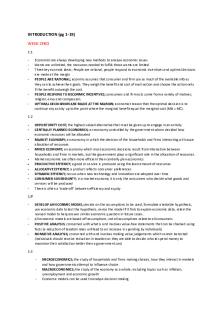Types of Arguments - textbook notes PDF

| Title | Types of Arguments - textbook notes |
|---|---|
| Course | Introduction to Writing |
| Institution | Utah Valley University |
| Pages | 2 |
| File Size | 42.9 KB |
| File Type | |
| Total Downloads | 73 |
| Total Views | 145 |
Summary
textbook notes...
Description
Types of Arguments 1. Classical Arguments a. Throughout a classically structured argument, you’ll rely on ETHICAL, EMOTIONAL, and LOGICAL appeals to your audience. i. Ethical appeals (those that build your credibility) are especially effective in the introduction, while logical and emotional appeals may be useful anywhere. b. The Introduction i. It engages the interest and attention of its audience by establishing the importance of the issue, by establishing COMMON GROUND with the audience and showing how they are affected by the argument, and by establishing the author’s CREDIBILITY. ii. To engage the audience, you might begin with a quotation or anecdote, ask a provocative question, or state the issue explicitly. iii. Most writers taking a classical approach state the CLAIM in the introduction; students making an academic argument usually do so in an explicit THESIS statement. c. The Body of the Argument i. It provides any necessary background information, followed by REASONS and EVIDENCE in support of the claim. ii. This section should make clear how the argument you’re making is in the best interests of the audience. iii. It should acknowledge possible COUNTERARGUMENTS and alternative points of view, presenting them fairly and respectfully and showing how your own argument is preferable. d. The Conclusion i. It may summarize your argument, elaborate on its implications, and make clear what you want those in your audience to do in response. ii. Just as it’s important to open in a way that will engage their attention, you’ll want to close with something that will make them remember your argument – and act on it in some way. 2. Toulmin Arguments a. The Introduction i. It presents a CLAIM, one that others will find debatable. ii. If need be, you’ll want to carefully QUALIFY this claim using words like something or it may be that limit your argument to one you’ll be able to support. b. The Body of the Argument i. It presents good REASONS and EVIDENCE (which Toulmin calls “grounds”) in support of the claim and explains any underlying ASSUMPTIONS (Toulmin calls these “warrants”) that your audience needs to agree with in order to accept your argument. ii. You may need to provide further evidence (which Toulmin calls “backing”) to illustrate the assumptions. iii. Finally, you’d acknowledge and respond to any COUNTERARGUMENTS. c. The Conclusion i. It restates the argument as strongly and memorably as possible.
ii. You might conclude by discussing the implications of your argument, saying why it matters. iii. And you’ll want to be clear about what you want the readers to think (or do). 3. Rogerian Arguments a. The Introduction i. It identifies the issue and DESCRIBES it as fully and fairly as possible. ii. It then acknowledges the various viewpoints on the issue, using nonjudgmental language to show that you understand and respect the views of others. b. The Body of the Argument i. It discusses the various POSITIONS respectfully and in neutral language, presenting REASONS and EVIDENCE that shows how each position might be valid or acceptable in certain circumstances. ii. Then state your own position, also using neutral language. iii. You’ll want to focus on the commonalities among the various positions – and if at all possible, to show how those who hold other positions might benefit from the one your propose. c. The Conclusion i. It proposes some kind of resolution, including a compromise if possible and demonstrating how it would benefit all parties. 4. Invitational Arguments a. The Introduction i. It presents the topic, acknowledges that there are various POSITIONS and perspectives on it, and makes clear that the goal is to understand each viewpoint so that readers can decide what they think. b. The Body of the Argument i. It is where you’d DESCRIBE each perspective fairly and respectfully. ii. If you can, QUOTE those who favor each viewpoint – a way of letting them speak for themselves. c. The Conclusion i. It looks for COMMON GROUND among the various perspectives and calls on readers to consider each one carefully before making up their minds....
Similar Free PDFs

Types OF Validity - Notes
- 1 Pages

2. Standardisation of Arguments
- 2 Pages

Diagramming Arguments - Notes
- 9 Pages

PSYC209 Notes Types of Tests
- 3 Pages

skeleton notes of types fallacy
- 45 Pages

AIS-notes- textbook notes
- 15 Pages
Popular Institutions
- Tinajero National High School - Annex
- Politeknik Caltex Riau
- Yokohama City University
- SGT University
- University of Al-Qadisiyah
- Divine Word College of Vigan
- Techniek College Rotterdam
- Universidade de Santiago
- Universiti Teknologi MARA Cawangan Johor Kampus Pasir Gudang
- Poltekkes Kemenkes Yogyakarta
- Baguio City National High School
- Colegio san marcos
- preparatoria uno
- Centro de Bachillerato Tecnológico Industrial y de Servicios No. 107
- Dalian Maritime University
- Quang Trung Secondary School
- Colegio Tecnológico en Informática
- Corporación Regional de Educación Superior
- Grupo CEDVA
- Dar Al Uloom University
- Centro de Estudios Preuniversitarios de la Universidad Nacional de Ingeniería
- 上智大学
- Aakash International School, Nuna Majara
- San Felipe Neri Catholic School
- Kang Chiao International School - New Taipei City
- Misamis Occidental National High School
- Institución Educativa Escuela Normal Juan Ladrilleros
- Kolehiyo ng Pantukan
- Batanes State College
- Instituto Continental
- Sekolah Menengah Kejuruan Kesehatan Kaltara (Tarakan)
- Colegio de La Inmaculada Concepcion - Cebu









